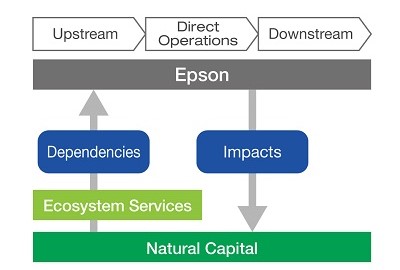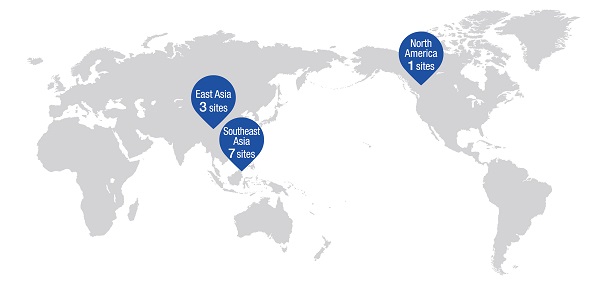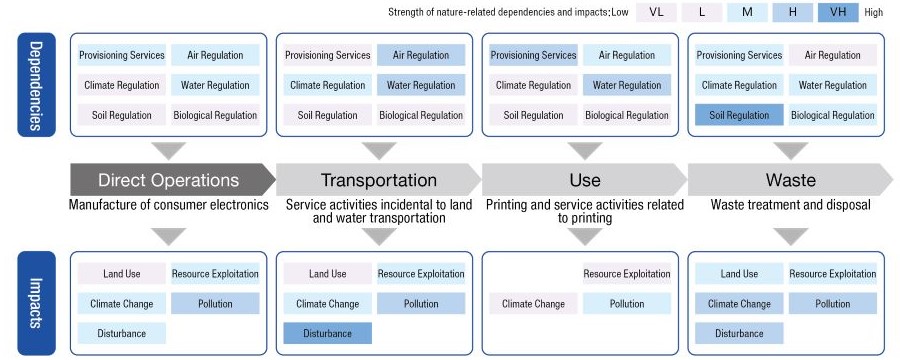Response to TNFD Recommendations
In June 2024, Epson expressed its support for the recommendations of the Taskforce on Nature-related Financial Disclosures (TNFD). We evaluated the Group's dependence and impact on natural capital and analyzed the associated risks and opportunities in accordance with the LEAP approach1 recommended by the TNFD framework. Based on this analysis, we will contribute to the realization of a sustainable society by minimizing our negative impact on nature and biodiversity and further harmonizing with local ecosystems.
1 The LEAP approach is an integrated approach for assessing nature-related issues, including nature contact, nature dependencies, impacts, risks, and opportunities.

Epson and natural capital
Epson's business activities and the lives of our employees are supported by the gifts of nature (ecosystem services) (dependency in the figure). In addition, our activities have a direct and indirect impact on nature (impact in the figure). The global loss of natural capital could severely disrupt our business activities and lives. To prevent the loss of natural capital, we must reduce our negative impact on nature. At the same time, as awareness of risks related to natural capital is increasing, we believe that Epson's technology can contribute to solving these issues. This also presents a business opportunity for Epson.

Governance
The Global Environmental Strategy Promotion Office and environmental subcommittees draft and implement company-wide environmental strategies, including those related to nature.
Management matters that are material to the entire Epson Group, including those related to nature, are discussed by the Management Strategy Council, an advisory body to the president. The Council periodically reports on these matters to the board of directors, which exercises appropriate supervision.
Strategy
Identification of priority regions
We assessed the risks to ecosystems and water at 42 sites in the Epson Group and identified 11 sites in North America, East Asia, and Southeast Asia as priority locations.
Priority locations (sites) for direct operations

Dependence and impact on natural capital
We conducted an evaluation and analysis to understand how our operations depend on and impact nature so that we could identify nature-related risks and opportunities. This enabled us to identify the business activities in our value chain processes (direct operations and downstream value chain) that depend on and impact natural capital, as well as the content of significant dependencies and impacts, as described below.
Analysis of dependence and impact of direct operations (including transportation) and processes downstream in the value chain

* The dependencies and impacts of business activities were analyzed using the visualization and evaluation tool ENCORE, and rated on a five-point scale (VH, H, M, L, VL).
* When there are multiple evaluation items, the evaluation is based on the item with the greatest dependency or impact.
* Disturbance: Activities that cause noise and light pollution that may harm living organisms.
Nature and biodiversity-related risks and opportunities and our response to them
We first identified risks and opportunities that are caused by, or depend on, nature. We then evaluated the importance of these risks and opportunities based on the likelihood of their occurrence and the degree of impact they would have. We identified six risks and two opportunities as material. The table below shows how we are responding to them.
| Category | Value Chain | Risks & Opportunities | Response | Actualization1 | |||
|---|---|---|---|---|---|---|---|
| Risk | Physical/Chronic | Direct operations | Water | Reduction and depletion of water resources Lower production volumes due to limited water availability |
|
Mid-term | |
| Water and soil pollution | Water pollution, soil pollution Environmental degradation caused by other stakeholders |
||||||
| Transition/Regulation | Water and hazardous substances | Stronger regulations on water source conservation, water intake, and pollution |
|
Short-term | |||
| Transition/Market | Water | Higher costs for improving water and energy efficiency | |||||
| Transition/Regulation | Resources and hazardous substances | Rules making mandatory the use of low-impact raw materials and stronger restrictions on the use of chemical substances |
|
Short-term | |||
| Transition/Market | Downstream | Environmental impact | Lower customer preference for products with high environmental impact | Short-term | |||
| Opportunities | Corporate perspective & nature & social perspective | Downstream | Environmental impact & resources | Enhancing Product & Corporate Value |
|
Mid-term | |
Company Perspective
|
Nature or Social Perspective
|
||||||
| Increasing need for solutions to environmental issues |
|
Mid-term | |||||
Company Perspective
|
Nature or Social Perspective
|
||||||
1 Short-term: by 2030. Medium-term: by 2050. Long-term: 2050 or beyond
Risk Management
As the environment in which companies operate becomes more complex and uncertain, Epson must effectively address risks that could materially impact corporate activities in order to execute its management strategies and business objectives.
Process to Identify, Assess and Manage Nature-Related Risks
| 1. Research | 2. Identify and assess | 3. Manage |
|---|---|---|
| Research the material nature-related dependencies and impacts at major sites in Japan and overseas. (Tools used 1: ENCORE, IBAT, Aqueduct, etc.) |
Qualitatively assess the seriousness of nature-related risks and opportunities to the organization in terms of their likelihood and impact. | Management the risks through the Management Strategy Council and board of directors |
1 Evaluation and analysis tools for assessing dependencies and impacts on natural capital and environmental risks, as recommended by TNFD.
Indicators and Targets
The Taskforce on Nature-related Financial Disclosures (TNFD) has recommended core global disclosure indicators. Epson found as a result of assessments that water and chemical substances are key nature-related risks. Resource circulation was also identified as a priority theme and is the reason we have launched efforts to use resources sustainably. We set these as nature-related targets. The results for FY2024 are summarized below.
| Theme | Related TNFD core indicator No. | Epson's Metrics | FY24 Targets | FY24 Results | |
|---|---|---|---|---|---|
| Water | Water use | C3.0 | Water use per unit of revenue (thousand m³/100 million yen) |
0.73 1% reduction from FY17-22 average |
0.62 |
| Water quality | C2.1 | Number of incidents in which legal limits were exceeded | 0 incidents/year | 1 incident | |
| Chemical substances (soil & air) |
- | Number of environmental law violations at business sites | 0 incidents/year | 0 | |
| Resources | C2.2, C2.3, C3.1 | Sustainable resource rate1 | 35% | 33% | |
1 The ratio of sustainable resources (renewable resources + circulated resources + less-depletable resources) to raw materials.



